1965 Triumph Spitfire, a name synonymous with classic British sports cars, marked a pivotal moment in automotive history. This two-seater roadster, with its sleek design and spirited performance, captivated drivers and enthusiasts alike. Born from a desire to create an affordable and accessible sports car, the Spitfire embodied the spirit of the swinging sixties, offering a thrilling driving experience that resonated with a generation.
The 1965 Spitfire was a product of meticulous engineering and design. Its lightweight chassis, coupled with a peppy 1.1-liter engine, delivered impressive performance for its time. The car’s distinctive styling, with its low-slung profile and chrome accents, became an instant classic, capturing the imagination of those seeking a blend of style and driving pleasure.
History and Background
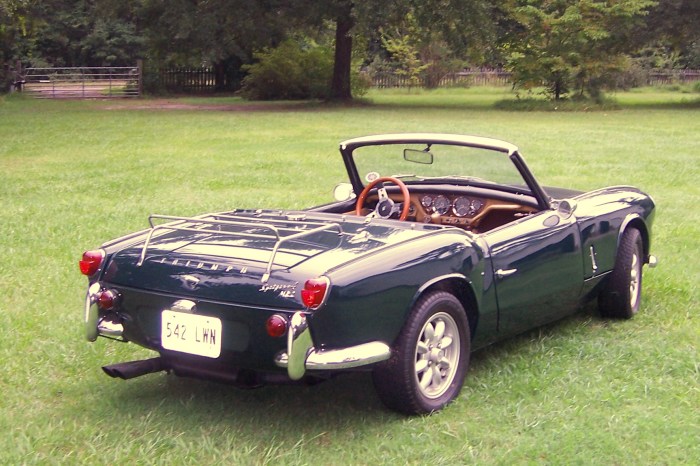
The Triumph Spitfire, a British roadster that captured hearts and imaginations, was born from a lineage of sporty Triumph models and a desire to create a lightweight, affordable, and exhilarating driving experience. Its story is one of innovation, evolution, and enduring appeal, shaping the landscape of the automotive world and becoming a symbol of the 1960s.The Spitfire’s roots can be traced back to the Triumph TR2, a two-seater sports car launched in 1953.
The TR2, with its powerful engine and rakish design, established Triumph as a force in the burgeoning sports car market. However, the company recognized the need for a more accessible and affordable model to broaden its appeal. This led to the development of the Triumph Herald, a compact saloon car introduced in 1959, which featured a lightweight monocoque chassis that would later become a defining characteristic of the Spitfire.
The Birth of the Spitfire
The Triumph Spitfire, conceived as a more affordable and accessible sports car than the TR series, was designed by Giovanni Michelotti, a renowned Italian automotive designer known for his elegant and flowing lines. Michelotti, working closely with Triumph’s engineering team, penned a design that combined classic roadster styling with modern features, resulting in a car that was both visually striking and aerodynamically efficient.
The Spitfire’s distinctive rounded bodywork, low-slung profile, and distinctive grille were a departure from the angular and aggressive styling of the TR models, offering a more approachable and elegant aesthetic.The Spitfire’s development was marked by several engineering innovations that contributed to its success.
The 1965 Triumph Spitfire, a nimble and stylish roadster, captured the hearts of enthusiasts with its sporty handling and charming design. While the Spitfire focused on affordability and agility, Triumph also offered the more powerful 1968 Triumph TR2 , a true grand tourer that emphasized performance and luxury.
Both cars, however, shared the same British heritage and a passion for driving pleasure, making them iconic representatives of the era’s automotive spirit.
The car was built on a shortened version of the Herald’s monocoque chassis, which offered a lightweight and rigid structure, allowing for a low center of gravity and nimble handling. The use of a tubular steel frame for the front suspension further enhanced the car’s agility and responsiveness.
The Spitfire was initially powered by a 1.1-liter four-cylinder engine, borrowed from the Herald, producing 65 horsepower. This engine, though modest in size, provided adequate performance for the lightweight roadster, delivering a top speed of around 90 mph.
Early Production and Marketing
The Triumph Spitfire, launched in 1962, was an instant success. Its combination of affordability, stylish design, and driving thrills captivated a wide audience, particularly among young buyers seeking an affordable and fun way to experience the open road. The car’s popularity was further fueled by successful marketing campaigns that emphasized its sporty character and its association with the burgeoning youth culture of the 1960s.Triumph’s marketing efforts focused on showcasing the Spitfire’s fun-loving and carefree image.
The car was featured in numerous magazine advertisements, often depicting young couples enjoying spirited drives through picturesque countryside. The Spitfire also made appearances in popular films and television shows, further cementing its association with the spirit of the times.
Cultural Impact and Legacy
The Triumph Spitfire’s arrival in 1962 coincided with a period of significant social and cultural change. The 1960s was an era of economic prosperity, social liberation, and a growing fascination with automobiles. The Spitfire, with its affordability, stylish design, and open-top driving experience, perfectly captured the spirit of the times, becoming a symbol of freedom, adventure, and youthful exuberance.
The car’s popularity extended beyond its intended market, attracting a diverse range of enthusiasts, from students and young professionals to established celebrities and motorsports enthusiasts.The Spitfire’s cultural impact was further amplified by its presence in motorsports. The car proved to be a competitive force in various racing series, particularly in the hands of skilled drivers who appreciated its lightweight chassis and agile handling.
The Spitfire’s success on the track helped to solidify its reputation as a true sports car, further enhancing its appeal among enthusiasts.The Triumph Spitfire’s legacy continues to resonate today. The car remains a popular choice among classic car enthusiasts, prized for its combination of affordability, stylish design, and driving enjoyment.
The 1965 Triumph Spitfire, a nimble roadster, was a popular choice for those seeking an affordable and fun driving experience. While the Spitfire was known for its compact size and lively handling, its bigger brother, the 1966 Triumph TR4A , offered a more substantial and luxurious driving experience.
The TR4A, with its larger engine and more refined styling, provided a compelling alternative for those seeking a more powerful and sophisticated roadster. The Spitfire, however, remained a beloved classic, offering a unique blend of affordability and driving enjoyment.
The Spitfire’s influence can be seen in the design of numerous modern sports cars, particularly in its emphasis on lightweight construction, agile handling, and a focus on the driving experience.
Design and Styling
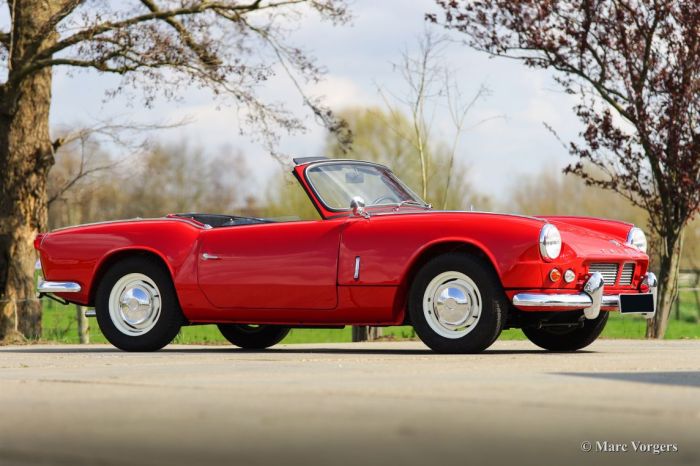
The 1965 Triumph Spitfire, despite its relatively small size, possessed a design that was both striking and undeniably British. It embodied the spirit of the era’s sports cars, offering a blend of classic elegance and a touch of playful aggression.
Distinctive Design Features, 1965 Triumph Spitfire
The 1965 Spitfire’s design was characterized by its iconic silhouette and several distinct styling elements. The car’s low-slung profile, with a long bonnet and a short rear deck, was a hallmark of sports cars of the time. The rounded, flowing lines of the bodywork created a sense of dynamism, even when the car was standing still.
- The grille, with its horizontal chrome bars and the prominent Triumph badge, served as a visual focal point, adding a touch of elegance and sophistication.
- The headlights, set into the front fenders, were round and slightly recessed, contributing to the car’s classic charm.
- The rear end, with its small, wraparound taillights and the integrated bumper, offered a clean and streamlined aesthetic.
- The removable hardtop, available as an optional extra, added versatility and allowed owners to enjoy the open-air experience.
Influence of Contemporary Design Trends
The 1965 Spitfire’s design reflected the prevailing trends of the era, which emphasized simplicity, functionality, and a touch of sporty flair. The car’s clean lines, uncluttered surfaces, and focus on essential elements were characteristic of the mid-1960s design aesthetic. The influence of the Italian coachbuilding tradition, particularly the work of designers like Pininfarina and Zagato, can be seen in the Spitfire’s sleek and elegant bodywork.
The car’s lightweight construction and emphasis on aerodynamics were also in line with the contemporary design philosophy, which prioritized performance and efficiency.
Comparison with Other Sports Cars
The 1965 Spitfire stood out amongst its contemporaries for its affordable price and its emphasis on driving enjoyment. While other sports cars of the era, such as the MG B and the Austin-Healey Sprite, offered similar performance and handling, the Spitfire’s design was more refined and sophisticated.
- The MG B, a direct competitor, featured a more rugged and utilitarian design, with a more upright windshield and a less streamlined body.
- The Austin-Healey Sprite, another rival, was even smaller and more compact than the Spitfire, with a less refined and more functional design.
The 1965 Spitfire, despite its modest size and affordable price, offered a compelling blend of classic British styling and contemporary design influences. It stood out as a stylish and enjoyable sports car, appealing to drivers who sought a balance of performance and affordability.
Technical Specifications
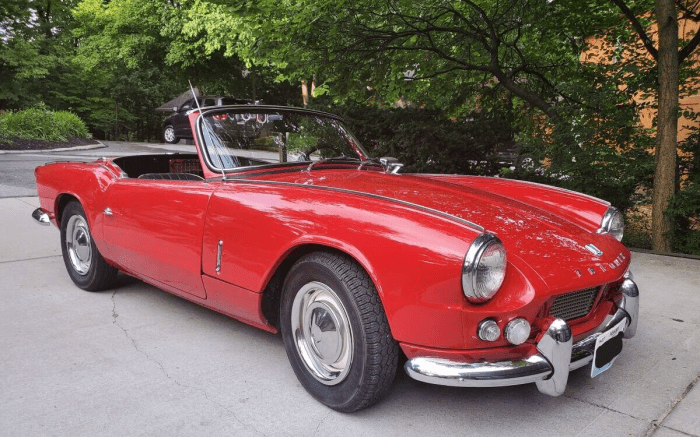
The 1965 Triumph Spitfire was a marvel of engineering, packing a potent engine and a lightweight chassis into a stylish and affordable package. This combination delivered a driving experience that was both exhilarating and engaging.
Engine and Transmission
The Spitfire was powered by a 1.1-liter four-cylinder engine, producing 65 horsepower. This engine, designed by Triumph, was known for its smooth operation and responsiveness. The engine featured a single overhead camshaft and twin SU carburetors, contributing to its lively performance.
The Spitfire’s engine was mated to a four-speed manual transmission, which provided precise and engaging gear changes. The transmission was renowned for its smooth and responsive operation, making it a pleasure to drive.
Chassis and Suspension
The Spitfire’s chassis was a lightweight and robust design, constructed from a combination of steel and aluminum. This construction allowed for a low center of gravity, which contributed to the car’s excellent handling characteristics. The suspension was a simple but effective design, featuring independent front suspension and a live rear axle.
The 1965 Triumph Spitfire, a lightweight roadster, was a popular choice for enthusiasts seeking a fun and affordable driving experience. While it shared the Triumph name with the more powerful and luxurious 1967 Triumph TR4A , the Spitfire carved its own niche with its smaller size and agile handling.
Its lively 1.1-liter engine and nimble chassis made it a joy to drive on winding roads, offering a distinct driving experience compared to its larger sibling.
This setup provided a comfortable ride and good handling, allowing the Spitfire to navigate corners with confidence.
Performance Capabilities
The 1965 Triumph Spitfire was a spirited performer, capable of reaching a top speed of around 90 mph. Its lightweight design and powerful engine enabled it to accelerate briskly, reaching 60 mph in approximately 12 seconds. The Spitfire’s handling was also a highlight, with its nimble and responsive nature making it a joy to drive on winding roads.
The car’s small size and precise steering allowed drivers to place it accurately through corners, making it a true driver’s car.
Key Technical Specifications
The following table provides a detailed breakdown of the key technical specifications of the 1965 Triumph Spitfire:
| Specification | Value | Specification | Value |
|---|---|---|---|
| Engine | 1.1-liter four-cylinder | Transmission | Four-speed manual |
| Power Output | 65 horsepower | Top Speed | 90 mph (estimated) |
| 0-60 mph | 12 seconds (estimated) | Weight | 1,450 lbs |
| Wheelbase | 84.3 inches | Length | 143.7 inches |
Driving Experience: 1965 Triumph Spitfire
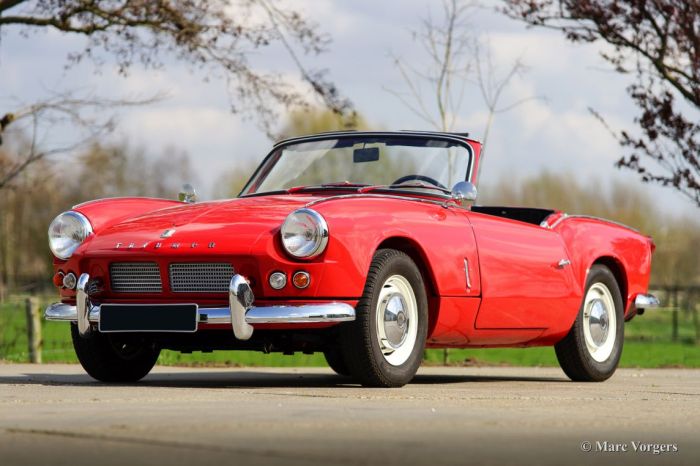
The 1965 Triumph Spitfire, with its lightweight design and nimble handling, delivers a driving experience that is both engaging and rewarding. The car’s responsiveness and agility make it a joy to drive on winding roads, while its simple mechanics offer a sense of connection to the machine.
Handling and Responsiveness
The Spitfire’s handling is characterized by its quick steering and predictable response. The car’s relatively short wheelbase and low center of gravity contribute to its agility and responsiveness. The suspension, although basic, provides a good balance between comfort and handling.
The car’s light weight also enhances its agility, allowing it to change direction with ease.
“The Spitfire is a car that begs to be driven on winding roads, its nimble handling and responsive steering making it a joy to navigate corners.”
Strengths and Weaknesses as a Driver’s Car
- Strengths:
- Nimble handling:The Spitfire’s light weight and short wheelbase make it exceptionally agile and responsive, particularly on winding roads.
- Engaging driving experience:The car’s manual transmission and relatively low power output require the driver to be more involved, creating a more engaging and rewarding driving experience.
- Simple mechanics:The Spitfire’s relatively simple mechanical design makes it relatively easy to maintain and repair, appealing to enthusiasts who enjoy working on their cars.
- Weaknesses:
- Limited power:The Spitfire’s 948cc engine produces only 65 horsepower, which can feel inadequate for highway driving or overtaking.
- Basic interior:The car’s interior is spartan and lacks many of the creature comforts found in modern cars.
- Limited practicality:The Spitfire’s small size and lack of trunk space make it unsuitable for carrying passengers or cargo.
Personal Experiences
The 1965 Triumph Spitfire is a car that evokes a sense of nostalgia and a connection to a simpler time. The experience of driving one is often described as exhilarating and liberating. The car’s open top design allows drivers to experience the world around them in a way that is simply not possible in a modern car.
The sound of the engine, the feel of the wind in your hair, and the sense of connection to the road are all part of the unique driving experience offered by the Spitfire.
“Driving a Spitfire is like stepping back in time. It’s a reminder of a simpler era when driving was about the experience, not just getting from point A to point B.”
Legacy and Impact

The Triumph Spitfire, particularly the 1965 model, has left an enduring mark on automotive history, becoming a symbol of affordable and stylish sports car driving. Its popularity continues to this day, attracting enthusiasts and collectors worldwide. The car’s influence extends beyond its technical specifications, reaching into popular culture and leaving a lasting legacy that resonates with generations.
The Spitfire’s Cultural Impact
The Triumph Spitfire’s appearance in numerous films, television shows, and music videos has solidified its status as a cultural icon. Its sleek design and sporty character have made it a popular choice for filmmakers seeking to portray a sense of freedom, adventure, and youthful rebellion.
- The 1965 Spitfire was featured in the 1968 film “The Thomas Crown Affair,” driven by Steve McQueen, further cementing its association with cool and sophistication.
- The car also appeared in the 1970s British television series “The Sweeney,” driven by the show’s protagonist, Detective Inspector Jack Regan, showcasing its association with law enforcement and action-packed pursuits.
- The Spitfire’s presence in music videos, such as The Cars’ “You Might Think” and The Cure’s “A Letter to Elise,” further highlights its versatility and appeal across different genres and eras.
Key Factors Contributing to the 1965 Spitfire’s Legacy
Several factors have contributed to the enduring legacy of the 1965 Triumph Spitfire:
- Affordable Sports Car:The 1965 Spitfire was a relatively affordable sports car, making it accessible to a wider audience. This affordability contributed to its popularity, particularly among young drivers and enthusiasts.
- Stylish Design:The Spitfire’s sleek and distinctive design, characterized by its low-slung profile, rounded bodywork, and chrome accents, made it a visually appealing car that captured the spirit of the 1960s.
- Driving Experience:The Spitfire’s lightweight construction, responsive engine, and nimble handling provided a rewarding and engaging driving experience. Its relatively small size and maneuverability made it fun to drive on both open roads and winding country lanes.
- Community and Enthusiasm:A strong community of Triumph Spitfire enthusiasts has emerged over the years, sharing their passion for the car, restoring and maintaining their vehicles, and participating in rallies and events. This shared enthusiasm has contributed to the car’s enduring popularity and its continued presence on roads around the world.
Epilogue
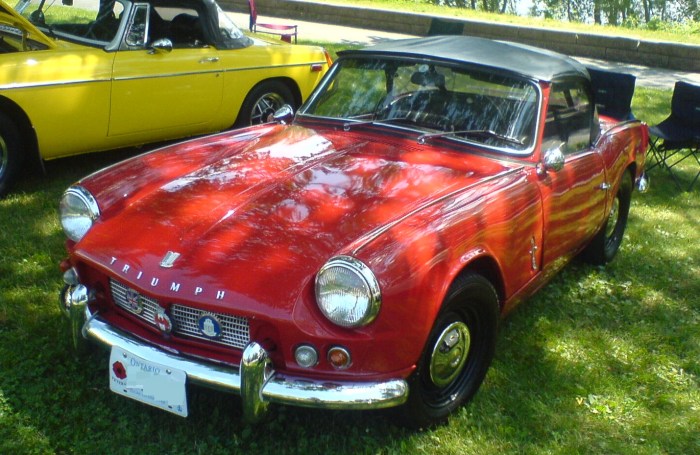
The 1965 Triumph Spitfire, a testament to British ingenuity and design, continues to hold a special place in the hearts of automotive enthusiasts. Its legacy extends beyond its technical specifications, encompassing a sense of nostalgia, freedom, and the joy of driving.
Whether cruising along scenic roads or participating in vintage car rallies, the Spitfire remains a timeless icon, reminding us of a bygone era when driving was an adventure.